BigFoot Networks Killer NIC: Killer Marketing or Killer Product?
by Gary Key on October 31, 2006 2:00 AM EST- Posted in
- Networking
Gaming Performance
As usual, gaming performance was tested with a variety of current games. We ran benchmarks at our standard 1280x1024 resolution. Given the number of users that run 19 inch LCDs these days, 1280x1024 represents one of the most commonly used resolutions at this time.
Battlefield 2
This benchmark is probably the most intense one we ran as it occurred on the Daqing Oilfield map with 64 players battling it out in a chaotic frenzy. This was also the most difficult map we had to experience from a viewpoint of keeping our players together and trying to accomplish the same tasks. If you saw two players constantly missing the vehicle rides and spending a lot of time in the trees sniping then it was us. We ran Battlefield 2 using the highest quality graphics settings available in the video settings. The game itself is best experienced with average in-game frame rates of 40 and up.
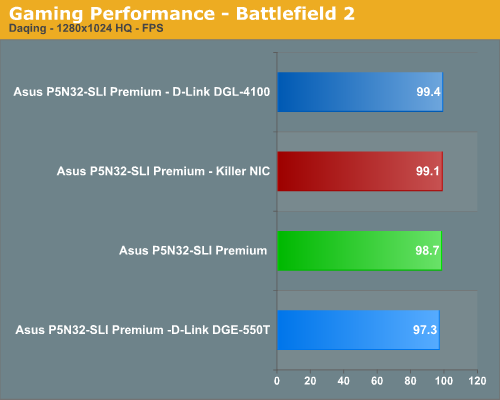

In our first game we actually find our D-Link combination performing slightly better than the other solutions from a benchmark viewpoint. During actual game play we noticed the frame rates and general smoothness of the system was best on the NVIDIA nForce 590SLI and followed closely by the Killer NIC. Several times during our testing with the D-Link DGL-4100 we would see several pauses while vehicles passed or several characters were in close proximity of each other. This behavior was worse on the D-Link DGE-550T when GameFuel was disabled on the router. In our first game we do not see $279.99 worth of game play improvement and the Killer NIC certainly did not allow us to dominate.
F.E.A.R.
We played both the Asylum and Deadwood 16-player maps. We decided to report the Asylum results as this is our favorite map currently. The Deadwood map generated similar results so we are not hiding any information. F.E.A.R. is a very graphics intensive game and we switch all graphic settings to maximum (except for soft shadows, which are disabled). An average frame rate for F.E.A.R. can dip into the teens at times which is not good for a first person shooter. We still found the game playable around 35fps or above in multiplayer.
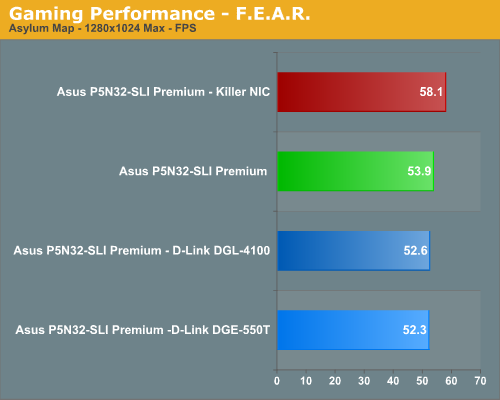

This is the money title for the Killer NIC. BigFoot Networks ships a copy of F.E.A.R. with every card so it should be expected to offer better frame rates and ping rates. We see a 7% increase in frame rates over the NVIDIA nForce 590SLI NIC and a 10% increase over the D-Link combination. In actual game play we found the Killer NIC to offer the most fluid experience and our ability to quickly transverse the map actually felt smoother than the other two solutions. The ping rates were actually higher than the D-Link router and nForce 590SLI but we did not find ping rate making a huge difference in this game. The question is did the Killer NIC improve our game play or skills? It really did not but it could for those who are significantly better players at this game than we are currently. In this case we will chalk a point up for the Killer NIC for improving frame rates.
Quake 4
This game should be a significant test for the Killer NIC as it requires extremely good hand to eye coordination along with lightning fast reflexes. This is just the game that would truly benefit from both improved ping and frame rates. We played on the Campgrounds Redux map with a total of 16 players. This is our favorite map from Quake III Arena and we were glad to see it return. We set our video settings to high and then fired up the game.
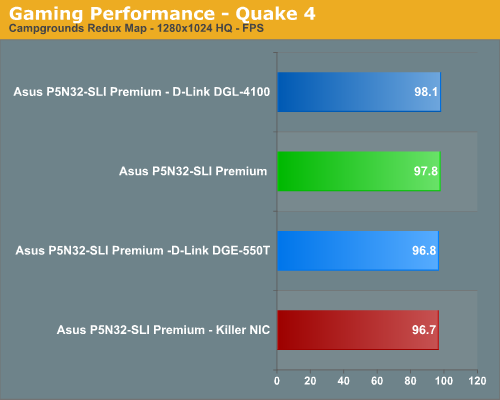
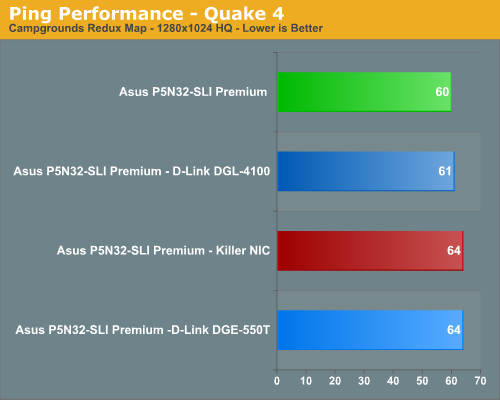
Actually, Quake 4 limits true frame rate to 60 fps during game play whether or not VSync is enabled. However, various timedemos and FRAPS will report the frame rate your system is capable of providing without the cap. In this case, we believe due to the speed of the game that ping rate is an extremely important performance measurement. This is one game where the Killer NIC loses on both fronts and it is mainly attributable to the excellent network code already provided in the game engine that does not benefit from offloading technology. The current performance leads us to believe we can expect to see the same results in the eagerly awaited Enemy Territory: Quake Wars.
Counter Strike Source
This is another game that BigFoot Networks touts as a premier title that will show improvements in both frame and ping rates. We are playing on the Office map with 32 players and we varied our online session times to ensure we were playing on a full server. Our settings were once again set to high quality at a 1280x1024 resolution. We find the game is very playable at 50 fps or better.
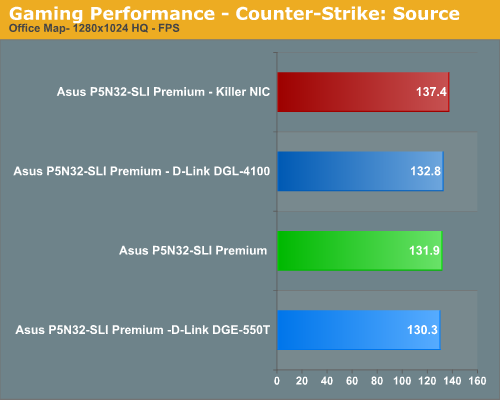

We did see frame rate improvements between three to five percent in this game. However, at these frame rates we really do not think a difference of 5% is going to matter much. Like Quake 4, an excellent ping rate in this game will make a difference and in this case we just did not see a large enough variation to make a difference in our experience. The Killer NIC did provide a positive experience to some degree in CSS as game play seemed to be a little smoother after firing your weapon than our other solutions. It was not a fire, frame hitch, and then move event we experienced a few other times during testing, especially with the D-Link PCI NIC. The Killer NIC gets a point for improving frame rates as advertised. We have to take it away for failing to improve our ping rates in a game where UltimatePing (reducing ping rates on the host system) could make a difference in actual game play.
Call of Duty 2
This is another popular shooter where frame rate and ping rate are very important especially in close quarters fighting. We played on the Caen map with a 24 player limit. The amount of packet processing this game generates is significantly higher at times than Counter Strike: Source so we expected our Killer NIC to shine in this area. Our video resolution is set to 1280x1024 with all options but AA enabled. We find the game is generally playable with a 40 fps or higher rate in multiplayer.
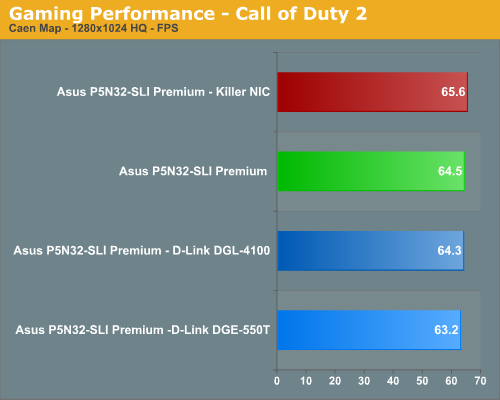
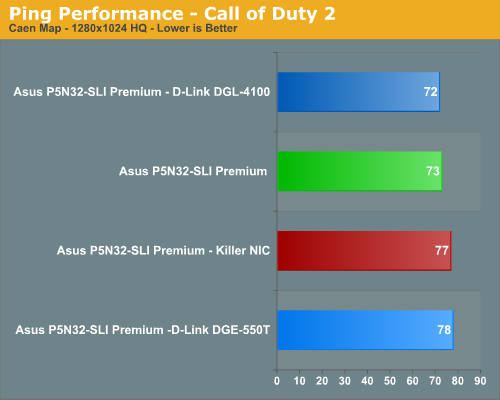
These results surprised us as we see minor frame rate improvements but ping rates were up to 7% greater than our D-Link router or NVIDIA NIC. The frame rate improvement is only worth mentioning because this game is generally GPU bound so any benchmark differences between systems is noticeable. Were the frame rate differences during game play noticeable? No they were not but we can tell you the increased ping rates were noticeable. This was the first game we encountered where the actual game play was not smooth with the Killer NIC. We noticed choppy break points at certain sections, especially when going building to building in the center of the map. We tried this map at different times during the day and noticed this issue several times. It seemed to be worse when throwing a grenade as we blew our selves up twice during testing. We might be slow and have weak arms in real life but our game characters did not need this handicap.
As usual, gaming performance was tested with a variety of current games. We ran benchmarks at our standard 1280x1024 resolution. Given the number of users that run 19 inch LCDs these days, 1280x1024 represents one of the most commonly used resolutions at this time.
Battlefield 2
This benchmark is probably the most intense one we ran as it occurred on the Daqing Oilfield map with 64 players battling it out in a chaotic frenzy. This was also the most difficult map we had to experience from a viewpoint of keeping our players together and trying to accomplish the same tasks. If you saw two players constantly missing the vehicle rides and spending a lot of time in the trees sniping then it was us. We ran Battlefield 2 using the highest quality graphics settings available in the video settings. The game itself is best experienced with average in-game frame rates of 40 and up.


In our first game we actually find our D-Link combination performing slightly better than the other solutions from a benchmark viewpoint. During actual game play we noticed the frame rates and general smoothness of the system was best on the NVIDIA nForce 590SLI and followed closely by the Killer NIC. Several times during our testing with the D-Link DGL-4100 we would see several pauses while vehicles passed or several characters were in close proximity of each other. This behavior was worse on the D-Link DGE-550T when GameFuel was disabled on the router. In our first game we do not see $279.99 worth of game play improvement and the Killer NIC certainly did not allow us to dominate.
F.E.A.R.
We played both the Asylum and Deadwood 16-player maps. We decided to report the Asylum results as this is our favorite map currently. The Deadwood map generated similar results so we are not hiding any information. F.E.A.R. is a very graphics intensive game and we switch all graphic settings to maximum (except for soft shadows, which are disabled). An average frame rate for F.E.A.R. can dip into the teens at times which is not good for a first person shooter. We still found the game playable around 35fps or above in multiplayer.


This is the money title for the Killer NIC. BigFoot Networks ships a copy of F.E.A.R. with every card so it should be expected to offer better frame rates and ping rates. We see a 7% increase in frame rates over the NVIDIA nForce 590SLI NIC and a 10% increase over the D-Link combination. In actual game play we found the Killer NIC to offer the most fluid experience and our ability to quickly transverse the map actually felt smoother than the other two solutions. The ping rates were actually higher than the D-Link router and nForce 590SLI but we did not find ping rate making a huge difference in this game. The question is did the Killer NIC improve our game play or skills? It really did not but it could for those who are significantly better players at this game than we are currently. In this case we will chalk a point up for the Killer NIC for improving frame rates.
Quake 4
This game should be a significant test for the Killer NIC as it requires extremely good hand to eye coordination along with lightning fast reflexes. This is just the game that would truly benefit from both improved ping and frame rates. We played on the Campgrounds Redux map with a total of 16 players. This is our favorite map from Quake III Arena and we were glad to see it return. We set our video settings to high and then fired up the game.


Actually, Quake 4 limits true frame rate to 60 fps during game play whether or not VSync is enabled. However, various timedemos and FRAPS will report the frame rate your system is capable of providing without the cap. In this case, we believe due to the speed of the game that ping rate is an extremely important performance measurement. This is one game where the Killer NIC loses on both fronts and it is mainly attributable to the excellent network code already provided in the game engine that does not benefit from offloading technology. The current performance leads us to believe we can expect to see the same results in the eagerly awaited Enemy Territory: Quake Wars.
Counter Strike Source
This is another game that BigFoot Networks touts as a premier title that will show improvements in both frame and ping rates. We are playing on the Office map with 32 players and we varied our online session times to ensure we were playing on a full server. Our settings were once again set to high quality at a 1280x1024 resolution. We find the game is very playable at 50 fps or better.


We did see frame rate improvements between three to five percent in this game. However, at these frame rates we really do not think a difference of 5% is going to matter much. Like Quake 4, an excellent ping rate in this game will make a difference and in this case we just did not see a large enough variation to make a difference in our experience. The Killer NIC did provide a positive experience to some degree in CSS as game play seemed to be a little smoother after firing your weapon than our other solutions. It was not a fire, frame hitch, and then move event we experienced a few other times during testing, especially with the D-Link PCI NIC. The Killer NIC gets a point for improving frame rates as advertised. We have to take it away for failing to improve our ping rates in a game where UltimatePing (reducing ping rates on the host system) could make a difference in actual game play.
Call of Duty 2
This is another popular shooter where frame rate and ping rate are very important especially in close quarters fighting. We played on the Caen map with a 24 player limit. The amount of packet processing this game generates is significantly higher at times than Counter Strike: Source so we expected our Killer NIC to shine in this area. Our video resolution is set to 1280x1024 with all options but AA enabled. We find the game is generally playable with a 40 fps or higher rate in multiplayer.


These results surprised us as we see minor frame rate improvements but ping rates were up to 7% greater than our D-Link router or NVIDIA NIC. The frame rate improvement is only worth mentioning because this game is generally GPU bound so any benchmark differences between systems is noticeable. Were the frame rate differences during game play noticeable? No they were not but we can tell you the increased ping rates were noticeable. This was the first game we encountered where the actual game play was not smooth with the Killer NIC. We noticed choppy break points at certain sections, especially when going building to building in the center of the map. We tried this map at different times during the day and noticed this issue several times. It seemed to be worse when throwing a grenade as we blew our selves up twice during testing. We might be slow and have weak arms in real life but our game characters did not need this handicap.










87 Comments
View All Comments
LoneWolf15 - Tuesday, October 31, 2006 - link
Almost forgot my one other point: As others have said, Vista's TCP stack is completely different. If the Killer NIC is designed largely around the way previous versions of Windows work, even with Vista drivers it could turn out to be a high-priced piece of hardware that functions no better than a regular PCI nic.TonyB - Tuesday, October 31, 2006 - link
Instead of paying $300 to improve your World of Warcraft PIng Times you can simply do a little research. find out which WoW server is located in your geographic zone. If you live in California, look for a West coast server, if you're in New York, look for a East coast server , if you're in Chicago look for a Central server. Pay the $25 character transfer fee and move your account to the new server, viola!! decreased ping times.ps: this only works if you aren't playing in a server thats in your geographic zone already.
VooDooAddict - Tuesday, October 31, 2006 - link
Because to you... Free = $25 transfer fee and no longer playing with the same group of friends?? Not an option for most people.I aplaud BigFoot for targeting this need with thier product. Riding the coat tails of something like WoW is a tried and true buisness practice. However, it's a failed execution and from the looks of it due mainly to the price. Everyone else agree that if priced for $49 or less they could start enjoying part of that big pile of money called WoW?
$49 for a card that could help keep things running smoothly in large raids with teamspeak running full tilt? They could drop the giant K and the embedded linux to help reduce costs as 95% of the WoW target wouldn't care about those features.
Spacecomber - Tuesday, October 31, 2006 - link
I'll try not to repeat what has already been said about this NIC and Anandtech's review of it; I did have a few random thoughts after skimming through the article.I felt like I had to give BigFoot credit for apprarently seeking out this review from Anandtech. Although they had a lot to gain from a good review, because of the extent of Anandtech's readership and reputation, they must have known that their card would have to deliver on what was advertised in order to get any sort of positive grade (and in the end it did fail to deliver on all but a insignificant fraction of what it promised).
On the other hand, this gets us to the meat of the article. Besides the issue of price, the main problem with this card is that it just isn't ready for prime-time, yet. This means that anyone who does spend $280 on this card is essentially signing up as a beta tester for a product this is still in development. Although gamers probably are familiar with this role (being the first to own some new hardware or new game means being the first to encounter unresolved and frustrating bugs), it still seems a bit perverse to have to pay so much money for this dubious honor.
Given that this seems to be current state of affairs with "cutting edge" games and hardware, I couldn't help imaginging how it would make more sense to put the (presumably) free products into the hands of users who know that they are expected to beta test and work with tech/support staff to make a potentially good product better, rather than the apparent current practice of putting new products into the hands of people who are only required to evangelize for the company.
I guess somewhere along the way the marketing people won out, and comapnies now find their money better spent on marketing rather than product development. Personally, I can't believe that viral marketing is going to be more helpful at making this product a success than would money spent on further testing and development.
Essentially, this is what BigFoot got by their providing a card to Anandtech for testing (constructive feedback and a willing partner to test out potential fixes - in the form of new drivers). But, I suppose BigFoot has bills to pay, now, before they can even worry about getting this card fully up to specification, and this means that someone has to pay.
WileCoyote - Tuesday, October 31, 2006 - link
Review was too wordy! Just large paragraphs of text without any type of organization. Dullest Anandtech article ever.goinginstyle - Wednesday, November 1, 2006 - link
Dullest response ever and it did not take a PhD to write my response. The article flowed from an introduction, with understandable technology descriptions that were not in other reviews, to results with a subjective/objective based ending. It had a couple of wordy sections but it was a lot better than most of the one line sentence descriptions you see in articles today. So please go buy a card, test it, and then provide us your perfect review. If you are unwilling to do this then at least tell us how it should be organized so anthropologists from around the world can understand it. I am sure Eric R. Wolf is turning over in his grave today because an anthropologist did not like the organization of an article.
WileCoyote - Thursday, November 2, 2006 - link
Chill out! Don't get so stressed out over 3 sentences and someone else's opinion. Big deal, I think it's a poorly written article when compared to previous ones at Anandtech. And I'm not questioning the author's education or net worth. I have left dozens of positive comments for previous Anandtech articles/authors so I'm not trolling either.goinginstyle - Thursday, November 2, 2006 - link
The fact is you have not offered an opinion on how to improve the article. You bash it but have not replied as to how you would have written it. If you think it is poorly written and have no issue critizing the author then at least leave a few comments on how you would have changed it. He at least asked for your opinion and others on how to improve the article. If you cannot respond in a professional manner to that request then you are trolling. Tell us how you would have organized the article? Better yet, test the card, and post your own review. You could simply take the time and email Gary with your revisions. He has already edited the article and the sections I thought were a little wordy are gone. Of course I emailed him and relayed my thoughts about the subject instead of dropping a one line dump in the forums.
WileCoyote - Friday, November 3, 2006 - link
Based on your replies I have learned the following:1. If you think an article is poorly written, buy the item and review it yourself.
2. If you do not write in a "professional manner" do not write anything at all. Ha!
3. If you say an article is "too wordy" people will not understand that the solution is to write less words.
4. Talking with people here is a big waste of time. They think they are always right and smarter than you.
The article was boring to me and I dropped a note to say that. I'm sorry for any hurt feelings as a result. If you know me better than I do and want to argue that the article was not boring to me, then feel free. Everything else you have said has nothing to do with what I originally said. I don't know, maybe you had a bad day at work and need to take it out here? Or maybe you want to aim at the easiest target in a thread... say, mine? Go find something challenging and worth spending time on. Unless this is the only way you feel smart? By the way, this post was too wordy. Boring even...yawn.
goinginstyle - Wednesday, November 29, 2006 - link
You must work in a really small cube. Yawn......